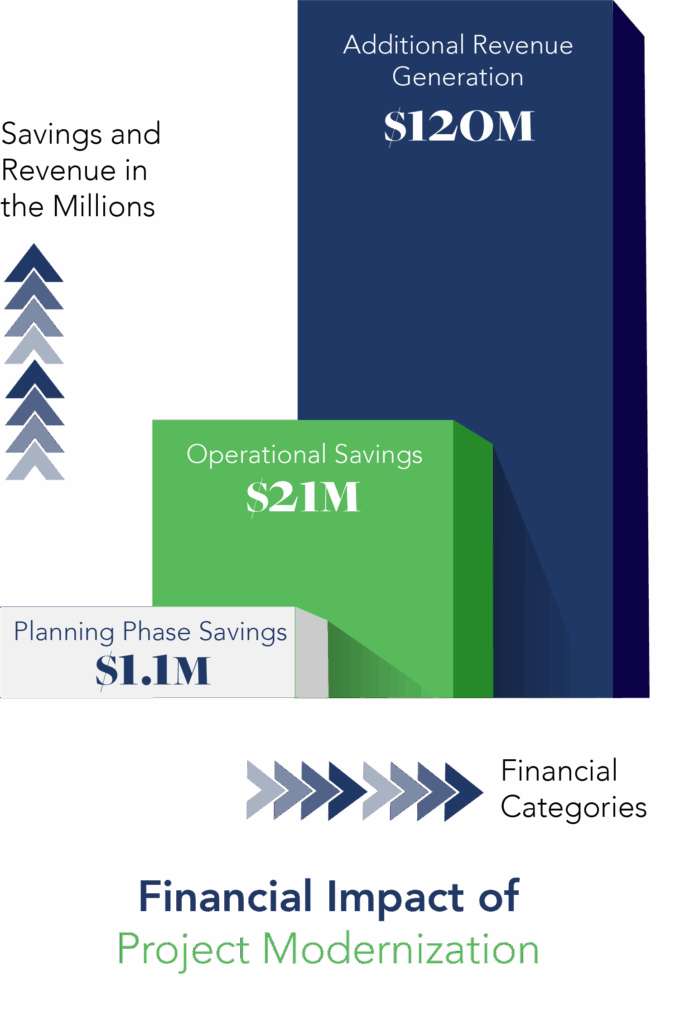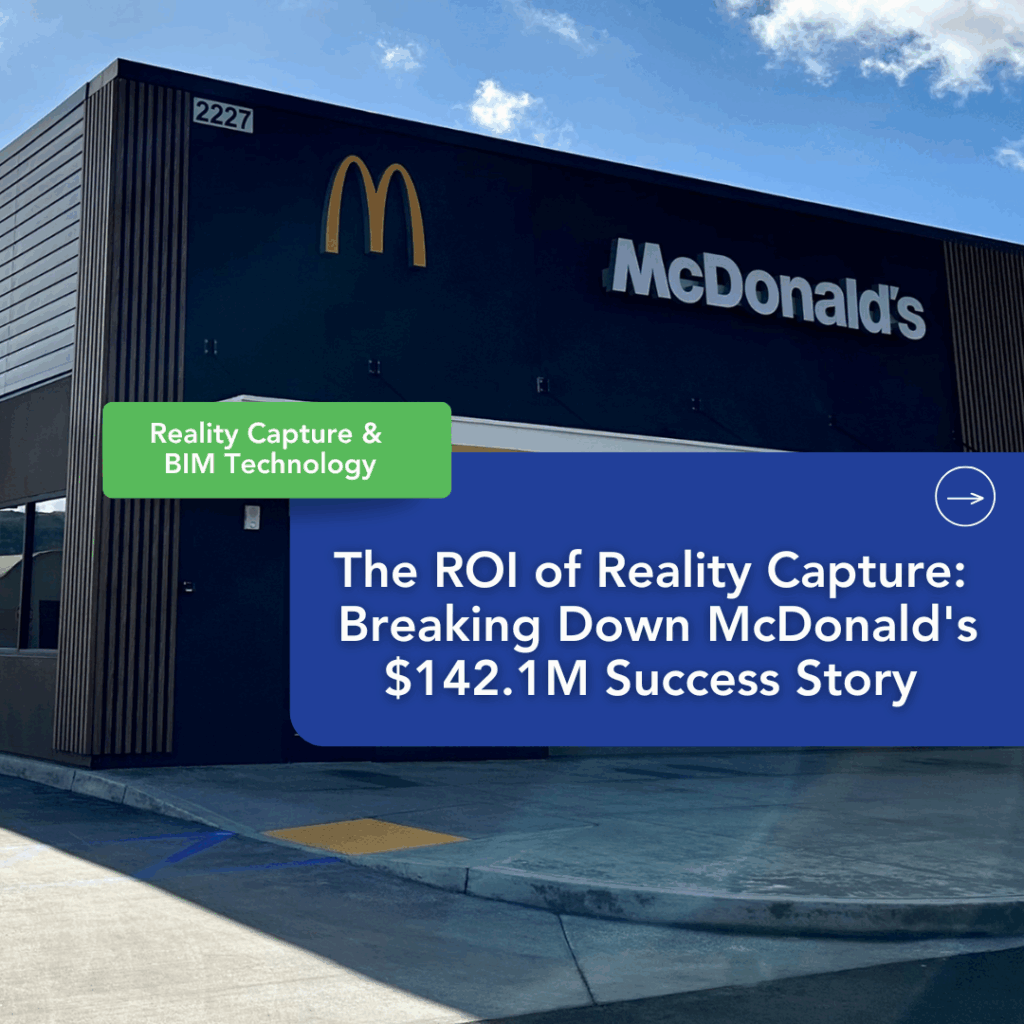When McDonald’s embarked on a comprehensive nationwide modernization program, the fast-food giant needed more than just a renovation plan, they needed a miracle in construction efficiency. What started as a pilot program for 650 locations in Southern California evolved into a nationwide transformation encompassing over 10,000 restaurant projects. By embracing Reality Capture and Building Information Modeling, McDonald’s achieved what seemed impossible: dramatically reducing project timelines while saving millions across the entire program.
The Initial Success: Southern California Pilot Program
The journey began with an ambitious pilot program in Southern California that would prove the concept and set the stage for nationwide expansion:
- 650 locations requiring varying modernization updates
- 140 drive-thrus needing complete reconstruction
- A 5-year projected timeline compressed to just 2.5 years
- $142.1 million in total savings and revenue generation
The Challenge: Scaling Success Nationwide
Following the overwhelming success of the Southern California pilot, McDonald’s faced an even more daunting challenge: replicating these results across thousands of locations nationwide. The numbers were staggering:
- Over 10,000 restaurant projects across the country
- Thousands of locations requiring varying updates and modernization
- Multiple regional variations and local building requirements
- The potential for massive cost overruns and timeline delays
Traditional program development approach would mean:
- Years spent on initial surveys and documentation
- Inconsistent implementations across diverse markets
- High change order rates leading to increased costs and schedule delays
- Extended restaurant downtime, impacting operations nationwide
McDonald’s needed a solution that could be consistently replicated across all markets while maintaining the dramatic cost savings and timeline reductions achieved in Southern California. This is where the full power of Reality Capture and BIM technology was implemented on a national scale.
The Game-Changing Solution: Nationwide Implementation of Reality Capture + BIM
McDonald’s partnership with Sevan Multi-Site Solutions (Sevan) introduced a technological revolution that would be replicated across the country, enabling the QSR (quick-service restaurant) chain to overcome the challenges of massive, multi-regional renovations.
Advanced Scanning Technology
- 360-degree digital scanning: Capturing precise, real-world data in every corner of thousands of locations nationwide
- Precise measurements: Delivering pinpoint accuracy for as-built conditions across diverse markets
- Comprehensive digital twins: Creating detailed, 3D representations of each restaurant for planning and analysis
- Remote scope development: Allowing teams to plan, design, and coordinate projects across the entire country without extensive on-site presence
Strategic Nationwide Implementation
- Standardized processes: Every location across all markets followed the same proven blueprint for consistency
- Real-time progress monitoring: Teams could track construction status on thousands of projects simultaneously
- Digital collaboration: Seamless communication across different regional teams ensured everyone was aligned
- Automated quality control: Leveraging technology to ensure construction adhered to McDonald’s strict standards regardless of location
The Complete Program Results: Beyond the Initial $142.1M Success
The Southern California pilot program’s $142.1 million success was just the beginning. This initial success led McDonald’s to expand the program nationwide, replicating the proven process across thousands of additional locations.
Initial Pilot Program Savings: $142.1M
Planning Phase Savings: $1.1M
- Reduced planning time: The planning phase, initially projected to take two years, was completed in just six months
- Eliminated redundant site visits: Remote data capture and analysis reduced the need for multiple costly on-site visits
- Streamlined approval processes: Faster decision-making thanks to accurate, up-to-date digital data
- Enhanced accuracy in initial assessments: Digital twins and precise measurements led to more accurate assessments of each site
Operational Savings: $21M
- Reduced change orders: Change orders, typically 10% of a project’s cost, were reduced to just 3%, saving McDonald’s $21 million
- Minimized construction errors: The accuracy of the data ensured that fewer mistakes were made on-site, avoiding costly rework
- Improved equipment ordering accuracy: With precise data on on-site conditions, the ordering process was streamlined, reducing delays
- Streamlined contractor coordination: Digital collaboration tools made it easier to manage contractors and avoid miscommunication

Additional Revenue Generation: $120M
- Completed 2.5 years ahead of schedule: The project’s completion in just 2.5 years allowed McDonald’s to begin reaping the benefits of the modernization sooner
- Faster return to operations: Restaurants could reopen quickly, minimizing downtime and maximizing revenue
- Earlier implementation of revenue-generating features: The accelerated timeline meant that the revenue-generating features of the modernized locations were up and running sooner
- Reduced operational disruption: With the digital planning tools in place, the construction process was less disruptive to ongoing operations
Nationwide Program Expansion
The success of the initial 650-location program led McDonald’s to continuously expand their partnership with Sevan, ultimately encompassing:
-
- Over 10,000 restaurant projects completed using the same proven methodology
- Consistent implementation of Reality Capture and BIM technology across all major markets
- Standardized processes replicated again and again, ensuring quality and efficiency nationwide
- Massive scalability proving the technology’s effectiveness across diverse geographic and regulatory environments
Key Success Factors
1. Precision Planning
- Digital twins enabled remote planning across thousands of locations, allowing for more accurate measurements and a more precise understanding of each site
- The technology provided a standardized approach to implementation across all markets, ensuring consistency and minimizing errors, regardless of location
2. Time Efficiency
- By reducing project timelines consistently across all locations, McDonald’s could achieve modernization goals much faster
- Faster site surveys and documentation, combined with streamlined approval processes, ensured projects moved quickly without sacrificing quality
3. Quality Control
- The use of digital twins and 360-degree scanning ensured that every location met McDonald’s exacting standards, reducing the need for rework
- Automated quality control tools helped monitor construction progress and maintain brand consistency across thousands of sites
4. Scalability and Replication
- The proven methodology from the initial pilot could be replicated seamlessly across different markets and regions
- Standardized processes allowed for efficient scaling from hundreds to thousands of projects
- Consistent technology implementation ensured predictable results regardless of project size or location
Lessons for Multi-Site Modernization
1. Technology Integration
- Investing in comprehensive digital scanning tools and using BIM for coordination are crucial for streamlining the modernization process across multiple markets
- Implementing real-time progress tracking and collaboration tools allows teams to stay aligned across thousands of projects
2. Process Standardization
- Developing repeatable workflows and creating digital templates helps maintain consistency across thousands of sites
- Establishing clear communication channels is essential to avoid delays and confusion across multiple regions
3. Resource Optimization
- Remote planning capabilities allow teams to minimize on-site requirements across vast geographic areas, saving time and money
- Efficient resource allocation and the use of accurate data reduce waste and optimize construction schedules at scale
The Future of Construction Modernization
McDonald’s comprehensive nationwide success story demonstrates how Reality Capture technology is transforming large-scale construction projects across entire industries.
The key takeaways are clear:
- Digital transformation drives significant cost savings: The use of Reality Capture & BIM led to millions in savings across thousands of projects
- Technology enables faster project completion: McDonald’s consistently completed projects in half the expected time across all markets
- Standardization improves quality and consistency: With the use of digital twins and precise data, McDonald’s maintained consistent standards across thousands of sites nationwide
- Scalability proves ROI: The ability to replicate success from 650 locations to over 10,000 projects demonstrates the true power of the technology investment
- ROI justifies the initial technology investment: The results speak for themselves—McDonald’s reaped massive rewards from investing in our Reality Capture & BIM services.
Ready to optimize your next modernization project?
Discover how Reality Capture and BIM services can deliver results comparable to those of McDonald’s for your organization.
